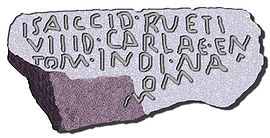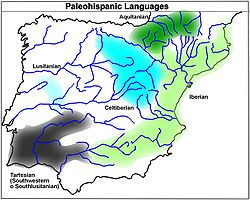
Lusitanian language
Encyclopedia

Paleohispanic languages
The Paleohispanic languages were the languages of the pre-Roman peoples of the Iberian Peninsula, excluding languages of foreign colonies, such as Greek in Emporion and Phoenician in Qart Hadast...
that apparently belonged to the Indo-European
Indo-European languages
The Indo-European languages are a family of several hundred related languages and dialects, including most major current languages of Europe, the Iranian plateau, and South Asia and also historically predominant in Anatolia...
family. Its relationship to the Celtic languages
Celtic languages
The Celtic languages are descended from Proto-Celtic, or "Common Celtic"; a branch of the greater Indo-European language family...
of the Iberian Peninsula, either as a member, a cousin (in a branch termed "Para-Celtic"), or as a different branch of Indo-European, is debated. It is known from only five inscriptions, dated from ca. 1 CE
Common Era
Common Era ,abbreviated as CE, is an alternative designation for the calendar era originally introduced by Dionysius Exiguus in the 6th century, traditionally identified with Anno Domini .Dates before the year 1 CE are indicated by the usage of BCE, short for Before the Common Era Common Era...
, and numerous names of places (toponyms) and of gods (theonyms). The language was spoken in the territory inhabited by Lusitanian tribes
Lusitanians
The Lusitanians were an Indo-European people living in the Western Iberian Peninsula long before it became the Roman province of Lusitania . They spoke the Lusitanian language which might have been Celtic. The modern Portuguese people see the Lusitanians as their ancestors...
, from Douro to the Tagus
Tagus
The Tagus is the longest river on the Iberian Peninsula. It is long, in Spain, along the border between Portugal and Spain and in Portugal, where it empties into the Atlantic Ocean at Lisbon. It drains an area of . The Tagus is highly utilized for most of its course...
rivers, territory that nowadays belongs mainly to Portugal
Portugal
Portugal , officially the Portuguese Republic is a country situated in southwestern Europe on the Iberian Peninsula. Portugal is the westernmost country of Europe, and is bordered by the Atlantic Ocean to the West and South and by Spain to the North and East. The Atlantic archipelagos of the...
, but also to Spain
Spain
Spain , officially the Kingdom of Spain languages]] under the European Charter for Regional or Minority Languages. In each of these, Spain's official name is as follows:;;;;;;), is a country and member state of the European Union located in southwestern Europe on the Iberian Peninsula...
.
Classification and related languages

Celtiberian language
Celtiberian is an extinct Indo-European language of the Celtic branch spoken by the Celtiberians in an area of the Iberian Peninsula lyingbetween the headwaters of the Duero, Tajo, Júcar and Turia rivers and the Ebro river...
.
Anderson (1985) and Untermann (1987) classify Lusitanian as a Celtic language. This is based largely on numerous apparently Celtic personal, deity, and place names. However, Lusitanian preserves the Proto-Indo-European initial *p-, as in Lusitanian porcom “pig”, whereas proto-Celtic lost that initial *p- at a much earlier date than that from which Lusitanian is attested; compare the Latin word for "father" pater with the Irish word athair and the Latin word for "full" plenus with Welsh llawn and Irish lán.
Villar and Pedrero (2001) connect Lusitanian with the Italic languages
Italic languages
The Italic subfamily is a member of the Indo-European language family. It includes the Romance languages derived from Latin , and a number of extinct languages of the Italian Peninsula, including Umbrian, Oscan, Faliscan, and Latin.In the past various definitions of "Italic" have prevailed...
. This is based on parallels in the names of deities and some lexical items, such as Umbrian
Umbrian language
Umbrian is an extinct Italic language formerly spoken by the Umbri in the ancient Italian region of Umbria. Within the Italic languages it is closely related to the Oscan group and is therefore associated with it in the group of Osco-Umbrian languages...
gomia, Lusitanian comaiam, as well as some grammatical elements. Prósper (2003) sees Lusitanian as predating the introduction of Celtic, and retaining Old European
Old European hydronymy
Old European is the term used by Hans Krahe for the language of the oldest reconstructed stratum of European hydronymy in Central and Western Europe...
elements of Indo-European.
Geographical distribution
Inscriptions have been found in Arroyo de la LuzArroyo de la Luz
Arroyo de la Luz is a municipality located in the province of Cáceres, Extremadura, Spain. According to the 2005 census , the municipality has a population of 6607 inhabitants....
(in Cáceres
Cáceres, Spain
Cáceres is the capital of the same name province, in the autonomous community of Extremadura, Spain. , its population was 91,131 inhabitants. The municipio has a land area of 1,750.33 km², and is the largest in geographical extension in Spain....
), Cabeço das Fragas (in Guarda
Guarda, Portugal
Guarda is a city in Guarda Municipality, Portugal. The city has a population of 32 111Guarda was founded in 1199 by the second king of Portugal, Sancho I....
) and in Moledo (Viseu
Viseu
Viseu is both a city and a municipality in the Dão-Lafões Subregion of Centro Region, Portugal. The municipality, with an area of 507.1 km², has a population of 99,593 , and the city proper has 47,250...
) and most recently in Ribeira da Venda. Taking into account Lusitanian theonyms, anthroponyms and toponyms, the Lusitanian sphere would include modern northeastern Portugal
Portugal
Portugal , officially the Portuguese Republic is a country situated in southwestern Europe on the Iberian Peninsula. Portugal is the westernmost country of Europe, and is bordered by the Atlantic Ocean to the West and South and by Spain to the North and East. The Atlantic archipelagos of the...
and adjacent areas in Spain
Spain
Spain , officially the Kingdom of Spain languages]] under the European Charter for Regional or Minority Languages. In each of these, Spain's official name is as follows:;;;;;;), is a country and member state of the European Union located in southwestern Europe on the Iberian Peninsula...
, with the centre in Serra da Estrela.
Writing system
The most famous inscriptions are those from Cabeço das Fráguas and Lamas de Moledo in Portugal and Arroyo de la Luz in Spain. Ribeira da Venda is the most recently discovered (2008). All the known inscriptions are written in the Latin alphabetLatin alphabet
The Latin alphabet, also called the Roman alphabet, is the most recognized alphabet used in the world today. It evolved from a western variety of the Greek alphabet called the Cumaean alphabet, which was adopted and modified by the Etruscans who ruled early Rome...
.
| Lamas de Moledo: | Cabeço das Fráguas: | Arroyo de la Luz (I & II): | Arroyo de la Luz (III): | Ribeira da Venda: |
RUFUS ET TIRO SCRIP SERUNT VEAMINICORI DOENTI ANGOM LAMATICOM CROUCEAI MACA REAICOI PETRANOI R(?) ADOM PORCOM IOUEAS(?) CAELOBRICOI |
OILAM TREBOPALA INDO PORCOM LAEBO COMAIAM ICONA LOIM INNA OILAM USSEAM TREBARUNE INDI TAUROM IFADEM REUE... A sheep [lamb?] for Trebopala and a pig for Laebo, [a sheep] of the same age for Iccona Loiminna, a one year old sheep for Trebaruna and a fertile bull... for Reve... |
AMBATVS SCRIPSI CARLAE PRAISOM SECIAS ERBA MVITIE AS ARIMO PRAESO NDO SINGEIETO INI AVA INDI VEA VN INDI VEDAGA ROM TEVCAECOM INDI NVRIM INDI VDEVEC RVRSENCO AMPILVA INDI LOEMINA INDI ENV PETANIM INDI AR IMOM SINTAMO M INDI TEVCOM SINTAMO |
ISACCID·RVETI · PVPPID·CARLAE·EN ETOM·INDI·NA.[ ....CE·IOM· M· |
[- - - - - -] XX•OILAM•ERBAM HARASE•OILA•X•BROENEIAE•H OILA•X•REVE AHARACVI•T•AV[...] IEATE•X•BANDI HARACVI AV[....] MVNITIE CARIA CANTIBIDONE• APINVS•VENDICVS•ERIACAINV[S] OVOVIANI[?] ICCINVI•PANDITI•ATTEDIA•M•TR PVMPI•CANTI•AILATIO |
Further reading
- Gorrochategui, Joaquín (1987): «En torno a la clasificación del lusitano», Actas del IV coloquio sobre lenguas y culturas paleohispanicas, pp. 2–3.
- Untermann, Jürgen (1997): «Lusitanisch, keltiberisch, keltisch», Veleia 2-3, pp. 57–76.
- Untermann, Jürgen (1997): Monumenta Linguarum Hispanicarum. IV Die tartessischen, keltiberischen und lusitanischen Inschriften, Wiesbaden.
- Villar, Francisco (1996): Los indoeuropeos y los orígenes de Europa, Madrid.
- Villar, Francisco; Pedrero Rosa (2001): «La nueva inscripción lusitana: Arroyo de la Luz III», Religión, lengua y cultura prerromanas de Hispania, pp. 663–698.
See also
- Pre-Roman peoples of the Iberian PeninsulaPre-Roman peoples of the Iberian PeninsulaThis is a list of the Pre-Roman peoples of the Iberian peninsula .-Non-Indo-European:*Aquitanians**Aquitani**Autrigones - some consider them Celtic .**Caristii - some consider them Celtic ....
- List of Celtic place names in Portugal
- Celtiberian languageCeltiberian languageCeltiberian is an extinct Indo-European language of the Celtic branch spoken by the Celtiberians in an area of the Iberian Peninsula lyingbetween the headwaters of the Duero, Tajo, Júcar and Turia rivers and the Ebro river...

